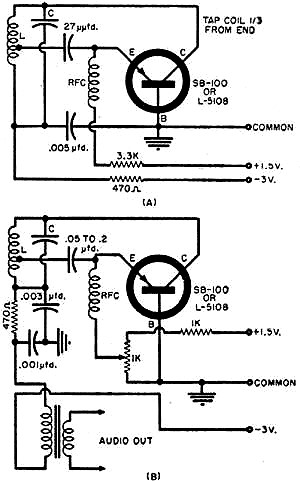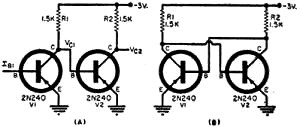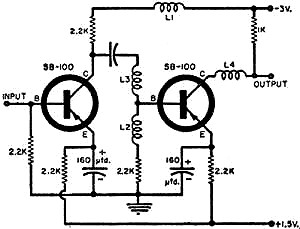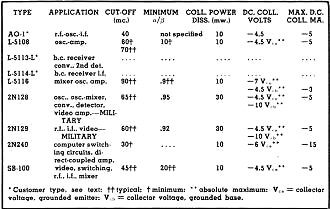|
According to the
Transistor Museum website, "The Philco Surface Barrier Transistor
(SBT) was the 'hottest' transistor around until the late 1950s. This device performed
very well at high frequencies and was used extensively in radio and computer circuits.
Hobbyists were delighted to find such an inexpensive high frequency device... [Edwin]
Bohr authored many well-remembered transistor construction projects in the 1950s/60s."
Many of Bohr's construction articles featuring SBTs were published in Radio
Electronics magazine, and this was one of them from 1957. The manufacturing
process is described where jet streams of an electrolyte were shot at both sides
of the germanium crystal to etch it as required - Neanderthal in nature compared
to today's etching processes.
The Amazing Surface Barrier Transistor
By Edwin Bohr
 Recent availability of SB transistors now
makes it important to learn something about these new types. Recent availability of SB transistors now
makes it important to learn something about these new types.
Years ago, when junction transistors were just beginning to nudge the one-megacycle
limit of useful operation, surface-barrier transistors were percolating away at
30 mc. and higher. And, to top it all, they were doing this with absurdly small
values of collector voltage and current - small even by ordinary transistor standards.
Today, the surface-barrier transistor, in its particular field of application, still
remains without peer.
Yet, in the popular technical magazines, this surface-barrier transistor has
received hardly more than a casual mention. The reason for this is simple. The SB
transistor has not been an "available" transistor. Surface-barrier transistors have
been with us for a long time, but only on an engineering sample basis; and their
development and potentialities largely have hidden in the laboratory and between
the pages of learned journals.
This situation has been given a complete about face. Anyone with a few dollars
in his pocket can now buy a surface-barrier transistor. In fact, he can choose from
several types. Some units have cut-off frequencies as high as 60 mc.
Surface-barrier transistors are beginning to appear in personal receivers and
automobile radios. At least one piece of ham gear has appeared using this fabulous
transistor. Military equipment, too, now employs the SB transistor, dispelling early
rumors that this unit was undesirably fragile and delicate. The current availability
of this component will undoubtedly kindle a wildfire of interest in surface-barrier
transistor applications and circuitry.
In this article we will hit the high spots of the SBT, its theory, history of
development, and present some practical applications and circuits. Some of the things
the SBT can do really make a person's mouth hang open. As an enticement to read
further, we will tell you in advance that one of the circuits is a scale-of-two
counter containing only four components - two SBT's and two resistors! If the SBT
is unique, which it is, some of its circuits are even more unique.
The Name

Fig. 1 - Jets of electrolyte stream from nozzles toward
the germanium wafer during the manufacture of the SB transistor.
By now, the curious reader has undoubtedly wondered how the name "surface-barrier
transistor" is derived.
Briefly, we can hint at an answer to this question by indicating that the ordinary
diffused junction transistor contains two forms of semiconducting material. In contrast,
the SBT contains only one form. Available diffused junction transistors are either
p-n-p or n-p-n types. Available SBT's are simply n-type transistors. The emitter
and collector of the SBT both are formed by plating to the surface of germanium,
forming a surface-barrier rectifying interface.
Momentarily, we are dropping the theory right here. An understanding of semiconductor
physics is, of course, anything but easy and necessitates a broad knowledge in many
direct and accessory fields. After all, to run, one must first learn to crawl and
then to walk. We, alas, can't do it all in fifteen hundred words. However, we can
still give the reader plenty of good functional "walking" information. Don't worry,
we will be back to the theory in a few paragraphs.
History
The SBT is a development of the Philco Corporation and, at present, they and
Sprague Electric Co. are the only manufacturers. Just as the transistor was an outgrowth
of research into the field of solids, the SET was the result of further Philco research
into changes in the properties of germanium just beneath the crystal's surface.
Atoms of germanium behave very differently at the surface of a crystal from the
way they do in the interior. The changed behavior extends from the surface into
the crystal for a depth of about one ten-thousandth of an inch, forming a so-called
surface barrier. Scientists found the SB effect can be utilized to form a useful
amplifying semiconductor device if several special conditions can be met.
First, electrodes must be attached to the germanium in a way that will produce
a minimum distance between the collector and emitter. This distance between collector
and emitter must be the same order of thickness as the surface barrier. Second,
the germanium must be completely free from contamination or physical strain.
These are problems of the highest degree. Nevertheless, by the magic of modern
technology, they have been solved. In fact, the spacing between emitter and collector
in the SBT has actually been reduced to a few thousandths of a millimeter and with
tolerances of a millionth of an inch. This small miracle is accomplished by a clever
process called "electrolytic machining."
Electrolytic Machining

Fig. 2 - (A) Oscillator and (B) Superregenerative circuit.

Fig. 3 - (A) D.C. amp. (B) Bi-stable circuit.

Fig. 4 - Wide-band video frequency amplifier.
To begin the manufacture of SBT's, blanks of single-crystal n-type germanium
are cut and etched to a thickness of 0.003 inch. The blank is next placed between
two tiny glass nozzles, mounted on a common axis. Jets of electrolyte stream from
the nozzles toward the germanium wafer. An electric current passes through this
stream of electrolyte, removing the germanium under the point of impact, an action
that is the reverse of electroplating. Fig. 1 shows this arrangement clearly.
As the electrolytic machining proceeds, the emitter and collector surface barriers
begin to approach each other, the current density reduces, thus slowing down the
etching for vernier control of the process. This reverse-plating, or etch process,
has now caused two pits to form in the germanium blank The remaining thickness of
germanium between the pits can be controlled to ± 5%. Ninety to 120 seconds are
required for this etch.
By instantaneous reversal of current through the electrolyte, the drilling process
is stopped and indium emitter and collector electrodes are plated to the surfaces
of the cavities. All of this is done without interrupting the stream of electrolyte.
Indium, incidentally, is the same metal used to form the p-type germanium in p-n-p
junction transistors.
In the finished transistor the collector is twice as large in diameter as the
emitter. Hairlike leads are attached to the indium electrodes and the transistor
is ready for hermetic sealing into a small cylindrical case.
Performance
Cut-off frequencies for all transistors are given in terms of a grounded-base
circuit. For grounded-emitter and grounded-collector service, the high-frequency
performance begins to roll off at a frequency approximately equal to the grounded-base
cut-off frequency divided by the beta gain of the transistor.
Applying this rule, we see that a conventional diffused junction transistor,
with a 20 mc. cut-off and a beta of 60 performance-wise, begins to deteriorate at
one-third of a megacycle. In contrast, the SBT may have a cut-off frequency of 60
mc. and a beta of 10. This means the SBT gain is smooth up to six megacycles. Tests
made with the SBT show that it gives unprecedented performance as a superhet mixer.
Too, it has the largest bandwidth-gain product of any available transistor, making
it really practical for wide-band video and i.f. amplifier applications.
To top it all, the SBT does this at collector voltages and power levels remarkably
lower than those of conventional transistors. A 30 mc. SBT oscillator, for example,
can easily operate at a collector potential of 3 volts and a current of 0.5 milliamp!
A. portable receiver using the SBT's will operate from a small three-volt battery.
Using conventional transistors, about nine volts are usually considered to be necessary.
Characteristics
Table 1 provides the more important features on available Philco units. Of these,
the SB-100 was the first commercially available SBT. This SB-100 and the L-5108
are generally the most useful for high-frequency and amateur-band applications.
The L-5116 will oscillate to 90 mc.
Three SBT's, the AO-1, L-5113-L, and L-5114-L, are types made available for particular
customer requirements. The AO-1 is an inexpensive SBT and its user can probably
expect widely varying characteristics. Service technicians will find the L-5113-L
and L-5114-L used in battery sets. The L-5113-L is used for converter and second
detector service and the L-5114-L for i.f. applications.
Types 2N128 and 2N129 are military-version SBT's. Undoubtedly, personnel in the
armed services will be seeing plenty of these transistors in FM receivers.
Another SBT, the 2N240, is available for computer and high-speed switching circuits.
This type has controlled saturation characteristics, fitting it for numerous ultra-simple
direct-coupled "on-off" amplifier circuits. The meaning of "saturation characteristic"
will be explained later in the article.

Table 1 - Types and characteristics of typical Philco SB transistors.
Circuits
Surface-barrier transistor circuits are similar in most respects to those of
the p-n-p diffused-junction transistor. The electrode voltages and bias currents
have the same polarity. In the case of high-frequency operation there is really
no significant difference between schematics for SB and p-n-p transistors. For computer
applications, the differences are really quite startling.
Figs. 2A and 2B give surface-barrier circuits for operation at 20 mc. and higher
with suitable tuned circuits. For 30 mc. C may be approximately 100 μμfd.
and L 6 turns spaced to 1/2 inch on a 3/8-inch coil form. The 470-ohm resistors
are insurance against excessive collector current.
A direct-coupled amplifier and bi-stable circuit using the 2N240 are shown in
Figs. 3A and 3B. When you look at these circuits they appear to be printer's errors
or textbook-type simplified diagrams. But they aren't. These are good workable circuits.
Let's look at Fig. 3A and see how it operates.
As you may remember, the 2N240 has a controlled saturation characteristic, by
this we mean the voltage from collector to base, when the transistor is passing
the maximum collector current permitted by the collector resistor and the available
collector supply voltage. In other words, the voltage from collector to ground,
when the collector current has reached saturation, is called saturation voltage.
For the 2N240. the collector-to-emitter voltage with a saturation current of
2 ma. is -0.07 volt and -0.1 volt for a saturation current of 8 ma. Further characteristics
of the 2N240 state that an input signal of -0.1 volt from base to emitter will cause
only -150 microamps of collector current.
Now if we apply an input base current Ib1 of -0.3 ma. to V1
the collector voltage VC1 will drop to -0.07 volt which is direct-coupled
to V2. This is not enough voltage to make V2 conduct so that
VC2, the output voltage, is practically equal to the supply voltage.
However, if we decrease the input current, VC1 will increase, driving
V2 into saturation.
If we now connect the output lead to the input, the direct-coupled bi-stable
circuit of Fig. 3B results. With the addition of proper steering and control
circuits, this type of counter is capable of operating at frequencies higher than
the best vacuum-tube counters. The power dissipation and space requirements for
this computer circuit are extremely small.
The SB transistor is a hot-performing video amplifier. Using simple audio-amplifier-type
RC coupling, a two-stage SBT amplifier will have adequate response out past 3 mc.
Employing peaking coils, the circuit of Fig. 4 has a 9 mc. bandwidth and 28
db gain. Removing the coils, the bandwidth is still sufficient for good video response.
Surface-barrier video amplifiers are non-microphonic. We have replaced industrial-TV
video preamps with three-stage SBT preamps, eliminating all but trivial remaining
microphonics in the vidicon.
Entertainment radios, both portable and automobile, use the SBT, with circuits
almost identical to diffused-junction transistor sets.
Sometimes there is a protective circuit to prevent burnout of the converter or
input r.f. stage caused by too-large signal from signal generators, etc. This is
necessary because the emitter and collector connection wires inside the transistor
are almost microscopic and the thin base section is easily ruptured. Consequently,
the SBT is faster than the fastest fuse - and far more expensive.
Philco recommends gun-type soldering irons or conventional irons with isolation
transformers for bench work. Otherwise, possible leakage currents from the iron
and any other test instrument connected to the chassis may damage the transistors.
Conclusion
The surface-barrier transistor, its performance, and fabrication, are nothing
short of a modern technological tour-de-force. Yet, it does not stop here. Already
surface-barrier transistors, using the diffusion process (SBDT units) are able to
operate at tremendously higher frequencies than the present units. Some applications,
in fact, are spectacular enough to be classed as closely guarded military secrets.
Surface-barrier transistors, however, do not replace diffused-junction transistors.
They simply give the transistor circuit engineer new inspiration and unprecedented
performance in several special applications.
How far the SBT invades the entertainment market depends, among other things,
upon the number of SBT suppliers. Today, Philco and Sprague are the only makers.
Firms generally will not use a transistor unless there are several sources acting
as alternate lifelines in the event of strikes, material shortages, catastrophe,
etc. This lack of suppliers until now has held back transistorized power amplifiers
for automobile set and it will have the same effect on SBT radios.
Meanwhile, practical transistorization has been pushed past the ten-meter band
by SBT's. Next, the twelve TV channels will fall before the transistor. Anyone want
to service this transistorized TV booster? Don't laugh, it isn't too far off.
Posted May 3, 2023
(updated from original post
on 11/15/2013)
|














